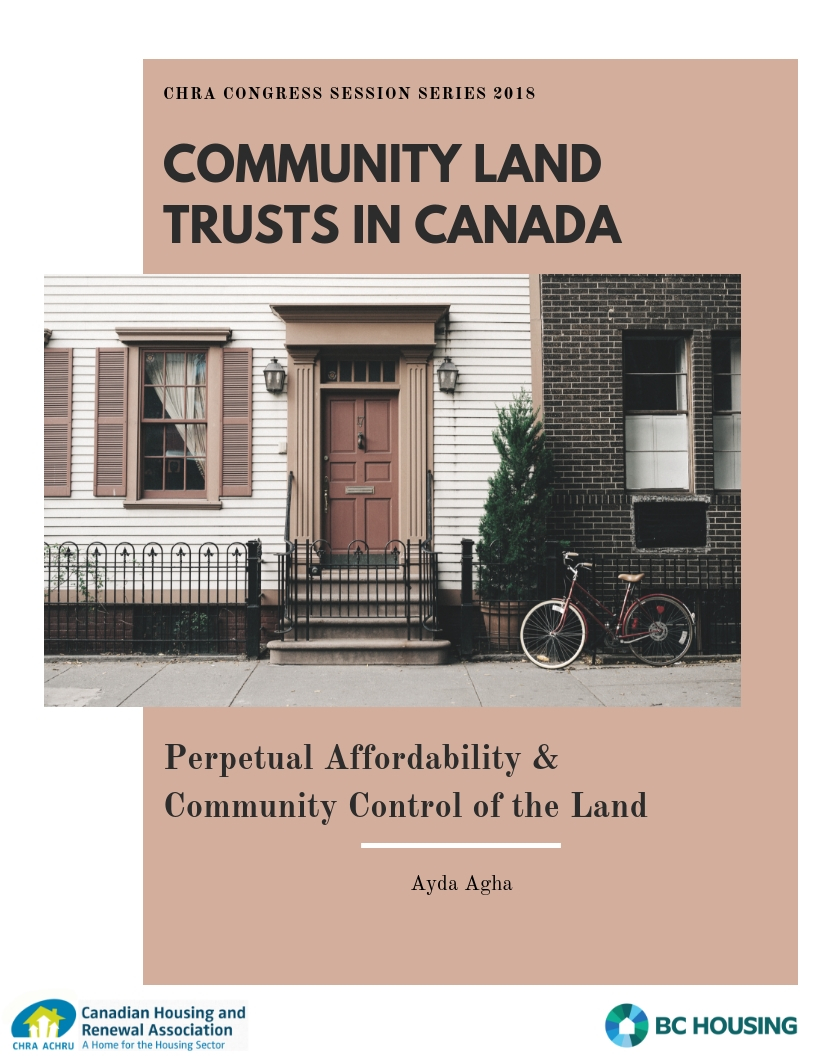 |
|---|
| Download the PDF version |
This is a summary of the workshop session ‘Perpetual Affordability and Community Control of the Land: Community Land Trusts in Canada’, which took place in Ottawa, on 26 April 2018 at the Canadian Housing and Renewal Association’s annual Housing and Homelessness Congress.
Throughout Canada the Community Land Trust movement is picking up speed. Community Land Trusts use a model that proposes an approach to land that ensures perpetual affordability and community control of the land. The model aims to align with the existing needs and characteristics of the communities in which it is used, and offers the opportunity to protect commercial properties, community gardens, co-ops, and single and multi-family homes from the speculative real estate market. This session provided an overview of emerging initiatives in Canada that bring into focus the collective vision for community land stewardship.
Paper by Ayda Agha, MSc. Community Health, Ph.D. Candidate Experimental Psychology, University of Ottawa
Panelists
Joshua Barndt, Executive Director, Parkdale Neighbourhood Land Trust (ON)
Marie-Sophie Banville, Community Development, Vivacité – Société Immobilière Solidaire (QC)
Stephanie Allen, Hogan’s Alley Trust & Vice President Project Planning & Partnerships, Catalyst Community Developments Society (BC)
Moderated by Lilian Chau, Community Investment Portfolio Manager, Vancity (BC)
Introducing Community Land Trusts in Canada and the Parkdale Model
What is a Community Land Trust?
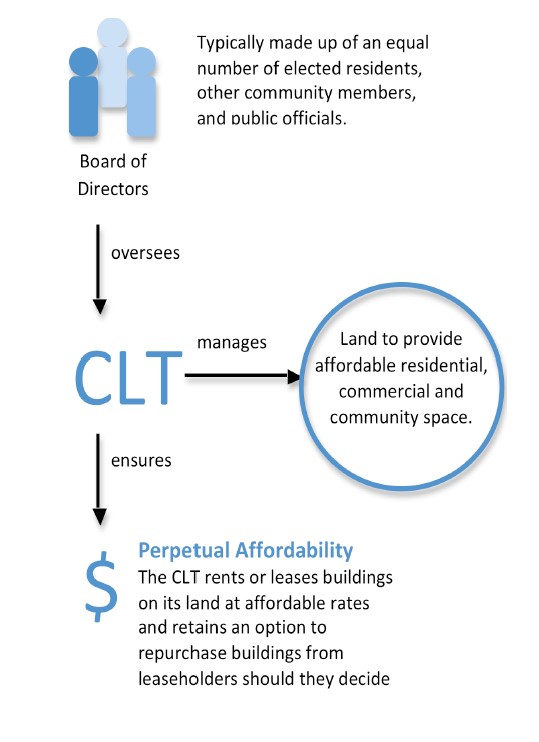 |
|---|
| Figure 1: standard Community Land Trust governance structure |
A Community Land Trust (CLT) is a non-profit corporation that obtains and holds land and housing for the benefit of the community in which it exists. With the shared value of housing as a right, the goal is to remove land and housing from the real estate market through either purchase or donation, and perpetually hold it in a trust to preserve the affordability of that land and housing asset.
A key feature that allows CLTs to maintain affordability is dual-ownership, the separation of land ownership (owned by the CLT) from ownership of the housing or buildings on the land itself, which is leased out to individuals or non-profit organizations over a long-term period. As Figure 1 illustrates, CLTs are designed to be membership-based organizations that are legally governed by an elected board of directors, often made up of lease holders and renters, community members, public servants, and non-profit organizations.
CLTs aim for flexible development and can take on a variety of activities, including supporting agriculture, residential housing, co-op housing, as well as home ownership. There are three predominant types of CLTs: community-based, sector-based, and publicly-based.
Community-based CLTs were first established in Albany, Georgia in 1969 and have their origins firmly based in the grass-roots civil rights movement of black Americans. With the belief that all power comes from land, the initial goal was to create new land tenure to secure greater economic and political independence for African-American farmers by establishing a community lease controlled by a non-profit organisation. The community-based CLT model is an innovative platform for community land ownership and preserving affordable housing. Additionally, it allows for equitable development without displacement, with the philosophy that community wealth should stay with the community and its current residents, as it revitalizes, develops, and as land values rise.
Sector-based CLTs are more common historically in Canada, with the first established in the 1970s as a means to preserve the affordability of cooperative housing and to pool resources of isolated co-ops. Key features include sector association sponsorship, development focus, and limited membership (as opposed to community-based membership).
Publicly-based CLTs are generally set up through government legislation that oversees public policy implementation related to land and housing. The key feature is there is usually no membership from the community, although sometimes there are representatives of community or resident group that may participate on the board.
The Parkdale Neighborhood Land Trust
 The Parkdale Neighborhood Land Trust (PNLT) is a grass-roots community-based CLT located in the gentrifying neighborhood of Parkdale in Toronto, with a focus on the maintenance of affordability. Parkdale is a rapidly changing community, and despite positive changes, many low-income individuals, including immigrants, refugees, and persons with disabilities, experience challenges regarding food and housing insecurity and affordable access to land.
The Parkdale Neighborhood Land Trust (PNLT) is a grass-roots community-based CLT located in the gentrifying neighborhood of Parkdale in Toronto, with a focus on the maintenance of affordability. Parkdale is a rapidly changing community, and despite positive changes, many low-income individuals, including immigrants, refugees, and persons with disabilities, experience challenges regarding food and housing insecurity and affordable access to land.
Due to condo developments in the area, cost of rent has rapidly increased in a community where 90 per cent of residents are renters and 36 per cent of households live in poverty, thereby pushing out lower profit land uses and lower income earners.
PNLT was established by seven local organizations as a response to gentrification and displacement in the Parkdale community. PNLT partnered with local organizations in Parkdale to secure land for community use, negotiate below-market purchase for owners, raise capital for acquisition and site planning through community donations and grants, and lead a community-based planning process with diverse residents to identify a plan for redevelopment of the site.
The trust allows for long-term land leases to non-profit housing partners and ensures that public investment and affordable housing is preserved and recycled. Land acquired can be used for affordable housing, affordable spaces for social enterprises and non-profit organizations, and urban agriculture, community gardens and open spaces. The model mirrors the classic American CLT tripartite governance structure that aims to balance the interest of individuals who directly benefit from the land as well as the community at large.
PNLT promotes community participation in guiding how land is used to benefit the community and keep Parkdale affordable and diverse.
La Propriété Solidaire – Vivacité – Société Immobilière Solidaire
Vivacité is a non-profit social enterprise and land trust. Its mission is to help low-to-moderate income households access housing ownership without down payment and ensure the homes remain perpetually affordable. This practice is called shared equity home ownership, and is a model commonly used in American CLTs.
A strong part of Vivacité’s mission is to use home ownership as a tool to build more equitable and resilient communities within cities and rural settings. In cities, Vivacité offers an ethical housing choice for the middle-class in urban neighbourhoods. In rural settings, housing is used as a means of combating demographic decline.
Contrary to other home ownership programs, the organization invests in properties and not individuals. Using shared equity as a tool, Vivacité finds qualified owners looking to buy community properties, and provides a down payment (approximately 20 per cent) as an investment that is not tied to the home owners and remains locked into the property after re-sale.
Although structured differently than common CLT models, the down payment is an investment into the property and community, similar to the function of a land trust.
When the future owners take out a mortgage for the property, Vivacité signs a legal contract that recognizes the organization as investors and ensures a relationship with the property indefinitely. When the property is resold, the home owners get back the value of the mortgage they have paid, and if there is market appreciation, the equity is split between the home owners and the organization.
This feature is another way Vivacité functions similarly to other CLTs, with the philosophy that if there is a market appreciation, it is a collective value, not one that individuals produce, and therefore it should be shared. Market appreciation on the property is then re-invested in the down payment of that property for the next buyer, in other properties in rapidly gentrifying neighbourhoods, or in new developments.
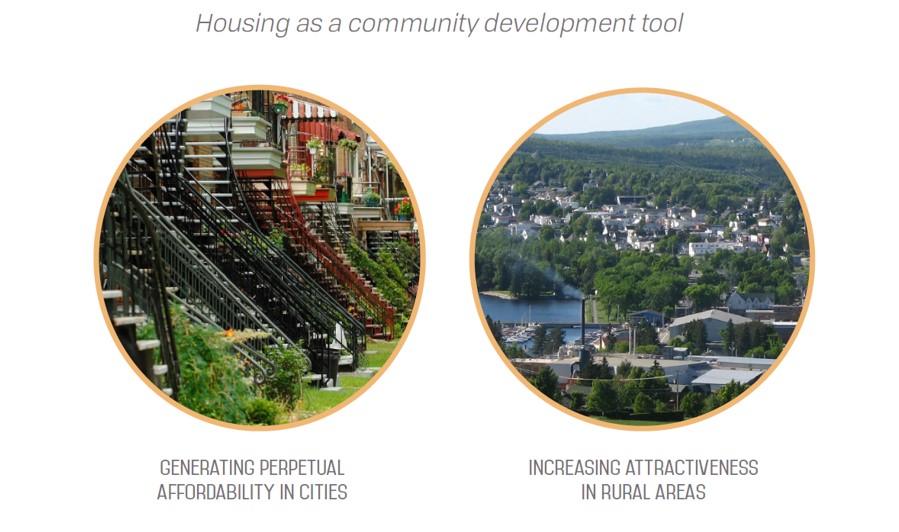 Vivacite’s shared equity program is based on a social economy model that leverages impact investors. This enables them to deliver perpetually affordable housing without subsidies or government aid. The shared equity home ownership model can also help build communities, by helping maintain perpetual affordability in neighbourhoods and decrease instances of urban sprawl.
Vivacite’s shared equity program is based on a social economy model that leverages impact investors. This enables them to deliver perpetually affordable housing without subsidies or government aid. The shared equity home ownership model can also help build communities, by helping maintain perpetual affordability in neighbourhoods and decrease instances of urban sprawl.
There is a large unmet housing need for lower middle-class households to build equity and to prevent future risk of poverty. There have been many developments over the years in providing individuals and households options in moving from homelessness to renting, but few programs in Canada exist that focus on moving from renting to home ownership that are both sustainable and do not increase gentrification. This is important for housing affordability in addressing negative inter-generational injustices, where children in future generations may need to rely on wealth generated by their parents to secure future housing.
Hogan’s Alley Society Land Trust
In the early 1900s, Black immigrants fled racial violence in the US and moved to Canada. Still facing discrimination and not welcome in many communities, these immigrants settled in Vancouver’s Eastside in a little corner that came to be known as Hogan’s Alley.
As the community grew, so did the neighbourhood’s social, economic and cultural attributes. Eventually, however, the community was lost as a result of municipal neglect and rezoning laws that depreciated property value and left the neighbourhood to fall apart. Expropriations also took place, and the city bought land that was often boarded up or abandoned, further hurting land value.
The 1957 National Housing Act, in which infrastructure development led to forced displacement, was additionally detrimental to the community. A freeway was mapped across Hogan’s Alley leading many black community members to leave. Having escaped the American Civil War, black community members were not interested in engaging in another conflict.
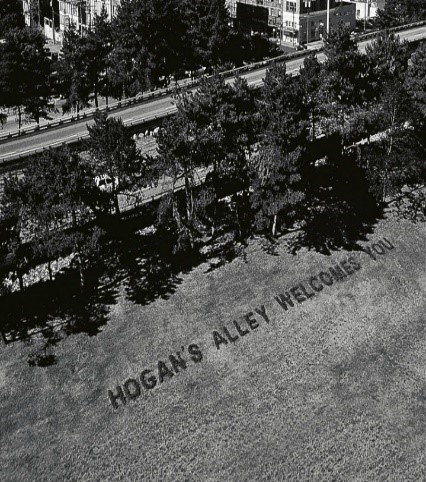
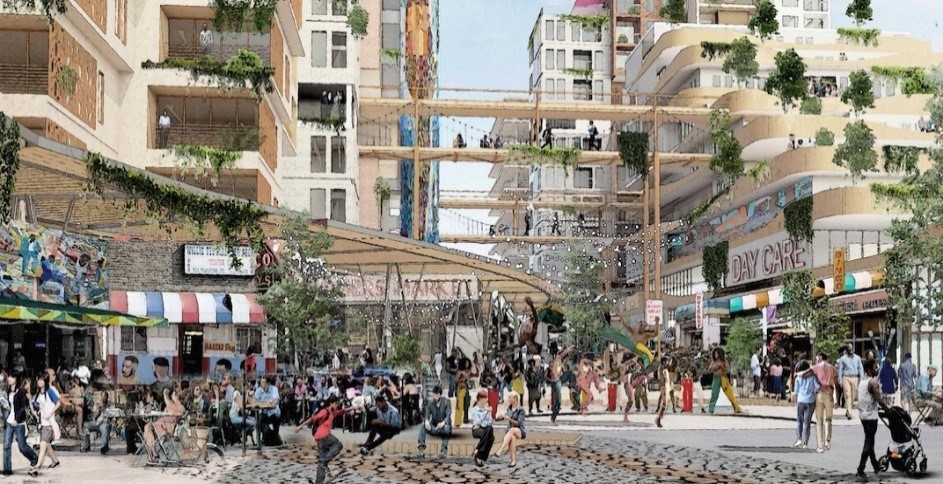
Despite challenges and institutional racism faced by black community members, there are several efforts through art, music, writing, and storytelling, that seek to keep the memory of Hogan’s Alley alive. When the City of Vancouver once again decided to redevelop the area, activists, academics, and artists came together to ensure that the black community was consulted in revisioning the neighbourhood.
Through negotiations with the City, the Hogan’s Alley Society created guiding principles important to redevelopment and has successfully secured areas that can be turned into cultural community assets. By including racially marginalized voices in city planning the Society works to ensure that redevelopment does not reproduce historical harm or future displacement of black community members.
Hogan’s Alley is a powerful example of community coming together to place political pressure to hold onto community assets for the benefit of the public.
In Summary
Although there are positive benefits to urban development and neighbourhood upgrading, low-income residents rarely experience the benefits. Gentrification (PDF) often drives up the cost of housing across the area and causes displacement of the low-income and working-class residents from the communities where they have traditionally lived1. Moreover, according to recent 2017 affordability measures, housing affordability (PDF) strains continue to intensify in Canada with little relief in sight2.
The Canadian Housing and Renewal Association’s Congress 2018 workshop session ‘Perpetual Affordability and Community Control of the Land’ discussed the Community Land Trust model as an approach to ensure perpetual affordability and community control of the land.
Community land trusts have proven to be an effective model to obtain and secure land for housing and offers opportunities to protect commercial properties, community gardens, co-ops, and family homes from the real estate market. The shared equity model allows the possibility for low-to-moderate income households to access housing ownership and build wealth and equity over time.
While there are limitations to consider and challenges in using a community land trust model, there are various tools that facilitate community stewardship, including leveraging political pressure, engaging with municipalities, and addressing gentrification and urban sprawl with innovative partnerships and community-based planning.
Endnotes
1. See, for instance, Robert Alan Walks and Richard Maaranen. The Timing, Patterning, and Forms of Gentrification and Neighbourhood Upgrading in Montreal, Toronto, and Vancouver, 1961 to 2001 (PDF). Centre for Urban and Community Studies, Cities Centre, University of Toronto (2008).
2. See Craig Wright and Robert Hogue. Housing Trends and Affordability (PDF). RBC Economics Research (2017).
